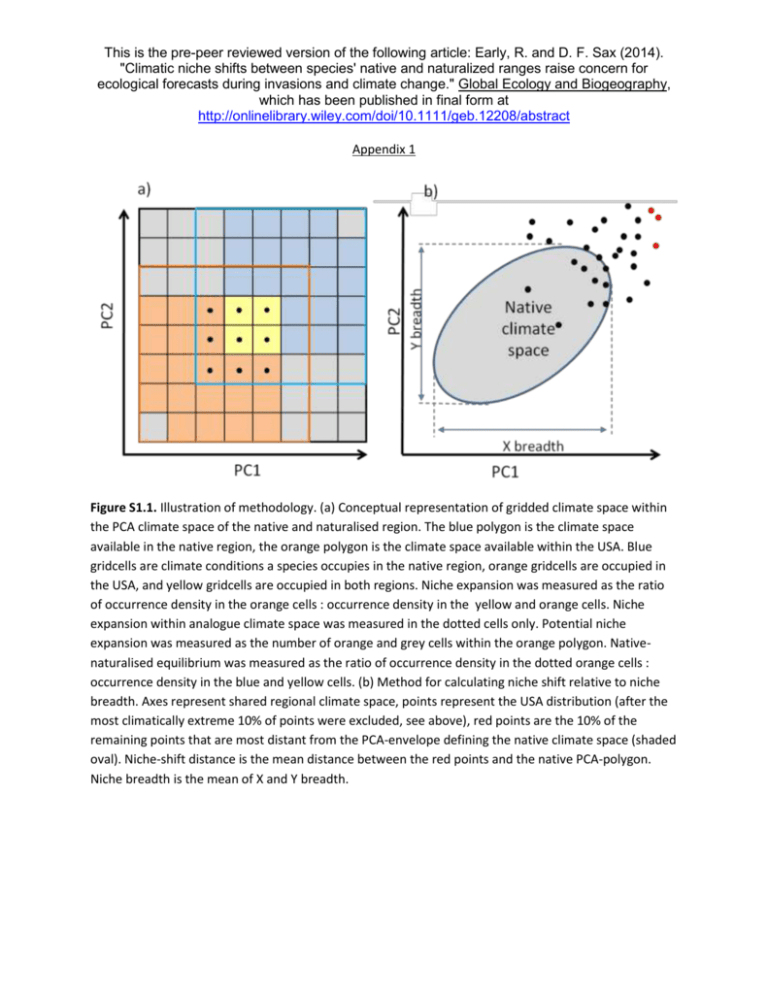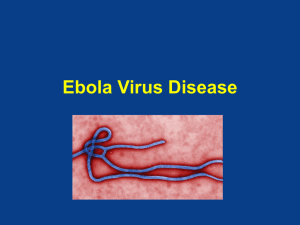This is the pre-peer reviewed version of the following article: Early, R
advertisement

This is the pre-peer reviewed version of the following article: Early, R. and D. F. Sax (2014). "Climatic niche shifts between species' native and naturalized ranges raise concern for ecological forecasts during invasions and climate change." Global Ecology and Biogeography, which has been published in final form at http://onlinelibrary.wiley.com/doi/10.1111/geb.12208/abstract Appendix 1 Figure S1.1. Illustration of methodology. (a) Conceptual representation of gridded climate space within the PCA climate space of the native and naturalised region. The blue polygon is the climate space available in the native region, the orange polygon is the climate space available within the USA. Blue gridcells are climate conditions a species occupies in the native region, orange gridcells are occupied in the USA, and yellow gridcells are occupied in both regions. Niche expansion was measured as the ratio of occurrence density in the orange cells : occurrence density in the yellow and orange cells. Niche expansion within analogue climate space was measured in the dotted cells only. Potential niche expansion was measured as the number of orange and grey cells within the orange polygon. Nativenaturalised equilibrium was measured as the ratio of occurrence density in the dotted orange cells : occurrence density in the blue and yellow cells. (b) Method for calculating niche shift relative to niche breadth. Axes represent shared regional climate space, points represent the USA distribution (after the most climatically extreme 10% of points were excluded, see above), red points are the 10% of the remaining points that are most distant from the PCA-envelope defining the native climate space (shaded oval). Niche-shift distance is the mean distance between the red points and the native PCA-polygon. Niche breadth is the mean of X and Y breadth. This is the pre-peer reviewed version of the following article: Early, R. and D. F. Sax (2014). "Climatic niche shifts between species' native and naturalized ranges raise concern for ecological forecasts during invasions and climate change." Global Ecology and Biogeography, which has been published in final form at http://onlinelibrary.wiley.com/doi/10.1111/geb.12208/abstract Figure S1.2. Map of biogeographical regions used to assign chorotypes. This is the pre-peer reviewed version of the following article: Early, R. and D. F. Sax (2014). "Climatic niche shifts between species' native and naturalized ranges raise concern for ecological forecasts during invasions and climate change." Global Ecology and Biogeography, which has been published in final form at http://onlinelibrary.wiley.com/doi/10.1111/geb.12208/abstract Table S1.1. List of species studied, extent of native range and chorotype. Species Atriplex laciniata Atriplex micrantha Aurinia saxatilis Species code ATLA ATMI2 AUSA Bassia hirsuta Brassica oleracea Cerastium tomentosum Chenopodium bonus-henricus Consolida ajacis BAHI3 BROL CETO2 CHBO COAJ Coincya monensis COMO9 Native region and justification for inclusion if non European endemic European endemic European endemic Europe + western Turkey (GBIF records available) European endemic European endemic European endemic European endemic Europe + Turkey (GBIF records available) European endemic Dianthus plumarius Erucastrum gallicum Helleborus niger Helleborus viridis DIPL ERGA HENI6 HEVI European endemic European endemic European endemic European endemic Iberis amara IBAM European endemic Larix decidua Lepidium graminifolium LADE2 LEGR5 Lepidium heterophyllum LEHE2 European endemic Europe + Morocco, Turkey (GBIF records available), North Algeria & Syria (no GBIF records available). USA niche shift towards more precipitation, lower temperatures European endemic Lychnis viscaria LYVI2 Paeonia officinalis Philadelphus coronarius Pinus mugo Pinus nigra PAOF2 PHCO7 PIMU80 PINI Pinus pinaster PIPI6 Europe + Turkey (no GBIF records available). USA niche shift is towards more precipitation European endemic European endemic European endemic Europe + Algeria, Turkey (GBIF records available), mountainous areas of Morocco (records not available). USA niche shift towards less precipitation Europe + north Morocco (GBIF records available). Chorotype Atlantic Steppic Multi-regional Multi-regional Atlantic Mediterranean Multi-regional MediterraneanAtlantic MediterraneanAtlantic Alpine Continental Alpine MediterraneanAtlantic MediterraneanAtlantic Alpine Multi-regional MediterraneanAtlantic Multi-regional Mediterranean-Alpine Alpine Alpine Mediterranean Mediterranean This is the pre-peer reviewed version of the following article: Early, R. and D. F. Sax (2014). "Climatic niche shifts between species' native and naturalized ranges raise concern for ecological forecasts during invasions and climate change." Global Ecology and Biogeography, which has been published in final form at http://onlinelibrary.wiley.com/doi/10.1111/geb.12208/abstract Potentilla anglica Potentilla intermedia Polygonum patulum Ranunculus marginatus Ranunculus trilobus Reseda odorata POAN7 POIN8 POPA9 RAMA4 RATR2 REOD Rosa ferruiginea Rosa tomentosa Rosa villosa ROFE5 ROTO ROVI80 Rumex cristatus Rumex pseudonatronatus Salix elaeagnos RUCR2 RUPS SAEL Saponaria ocymoides Sagina subulata Sedum reflexum Sedum sexangulare Sempervivum tectorum SAOC80 SASU5 SERE4 SESE6 SETE5 Silene chlorantha Silene csereii Silene italica Silene nutans Silene pendula Spergularia echinosperma Spergula morisonii Stellaria palustris Thalictrum aquilegifolium Ulmus procera Urtica urens SICH4 SICS SIIT SINU2 SIPE3 SPEC SPMO2 STPA7 THAQ ULPR URUR European endemic European endemic European endemic European endemic European endemic Europe + Egypt and Libya (no GBIF records available). USA niche shift is towards more precipitation, warmer and cooler temperatures European endemic European endemic Europe + Iran, Turkey, Ciscaucasia (no GBIF records available). No USA niche shift European endemic European endemic Europe + north Turkey (no GBIF records available). No USA niche shift European endemic European endemic European endemic European endemic Europe + Morocco (no GBIF records available). No USA niche shift European endemic European endemic European endemic European endemic European endemic European endemic European endemic European endemic European endemic European endemic European endemic Multi-regional Boreal Multi-regional Mediterranean Mediterranean Mediterranean Alpine Multi-regional Multi-regional Mediterranean Boreal Mediterranean-Alpine Mediterranean-Alpine Multi-regional Multi-regional Multi-regional Mediterranean-Alpine Multi-regional Steppic Mediterranean-Alpine Multi-regional Mediterranean Continental Multi-regional Multi-regional Multi-regional Multi-regional Multi-regional This is the pre-peer reviewed version of the following article: Early, R. and D. F. Sax (2014). "Climatic niche shifts between species' native and naturalized ranges raise concern for ecological forecasts during invasions and climate change." Global Ecology and Biogeography, which has been published in final form at http://onlinelibrary.wiley.com/doi/10.1111/geb.12208/abstract Table S1.2. Sources of distribution data for species naturalised distributions in the USA. Many thanks to the people acknowledged, who helpfully extracted the data we needed from their databases. Provider name Regional coverage Number of grid-cells with data 27079 Arizona State University, International Institute for Species Exploration (via GBIF) Arizona Freeman Herbarium, Auburn University Brooklyn Botanical Garden Alabama New York, New Jersey, Connecticut California USA 3292 11766 Pennsylvania & Northeast USA Pacific Northwest California California Florida Michigan, Minnesota, Wisconsin USA Illinois Washington, Oregon, Idaho, Montana, Wyoming 1670 New England Florida Indiana 8772 1823 589 Berkeley Natural History Museums (via GBIF) BONAP - Biota of North America Program (http://www.bonap.org/MapSwitchboard.html). Chapel Hill, N.C. [maps generated from Kartesz, J.T. 2010. Floristic Synthesis of North America, Version 1.0. Biota of North America Program (BONAP). (in press)]. Wayne E. Manning herbarium, Bucknell University Burke Museum (via GBIF) California Invasive Plant Council California Consortium of Herbaria Fairchild Tropical Botanic Garden (via GBIF) Great Lakes Indian Fish and Wildlife Commission Harvard University Herbaria (via GBIF) Illinois Plant Information Network INVADERS Database System (http://invader.dbs.umt.edu). Invasive Plant Atlas of New England Florida Invasive Species Partnership IUSE Acknowledgements Curtis J. Hansen, Curator Steve Clemants & Steve Glenn 19098 140 Warren Abrahamson & Mike Weaver 82 77554 155138 981 4514 77 9663 171357 Rice, P.M. Division of Biological Sciences, University of Montana, Missoula, MT 598124824. This is the pre-peer reviewed version of the following article: Early, R. and D. F. Sax (2014). "Climatic niche shifts between species' native and naturalized ranges raise concern for ecological forecasts during invasions and climate change." Global Ecology and Biogeography, which has been published in final form at http://onlinelibrary.wiley.com/doi/10.1111/geb.12208/abstract University of Wisconsin Plant Ecology Laboratory (Waller, D.M, Amatangelo, K.L., Johnson, S., and D.A. Rogers. 2012. Plant community survey and resurvey data from the Wisconsin Plant Ecology Laboratory. Biodiversity and Ecology 4: 255-264. Purdue University Kriebel Herbarium (PUL), West Lafayette, Indiana Louisiana State University Herbarium Wisconsin 264 Katie Amatangelo Indiana 474 Nick Harby Louisiana 3405 Minnesota Minnesota 13108 Missouri Missouri 5438 Missouri Botanical Garden (via GBIF) Milwaukee Public Museum USA Wisconsin 9609 5009 National Museum of Natural History (via GBIF) New York Botanical Garden USA USA 5081 14602 New York Flora Atlas New York 12914 New York State Museum Oregon State University (via GBIF) PaFlora Southern Appalachian Information Node of the National Biological Information Infrastructure New York Oregon Pennsylvania North Carolina 44 18707 28614 272 Southeast Exotic Pest Plant Council Southeast USA 485 SEINnet Southwest 5256 Texas A&M University, biology department herbarium Tall Timbers Research Station Robert K. Godfrey Herbarium. Texas 1574 Monique Reed, curator South & Southeast USA 96 Dr. Kevin Robertson, Curator & Dr. Gil Nelson, Database Design & Management UCD (via GBIF) University of Louisiana at Monroe Herbarium California Louisiana 11423 3382 Neil T. Luebke, curator. Charles Sheviak This is the pre-peer reviewed version of the following article: Early, R. and D. F. Sax (2014). "Climatic niche shifts between species' native and naturalized ranges raise concern for ecological forecasts during invasions and climate change." Global Ecology and Biogeography, which has been published in final form at http://onlinelibrary.wiley.com/doi/10.1111/geb.12208/abstract University of Alabama Herbarium Alabama 1361 University of Alabama Biodiversity and Systematics (via GBIF) University of Colorado Museum (via GBIF) University of Connecticut (via GBIF) United States Department of Agriculture PLANTS database (http://plants.usda.gov/) Alabama 19 Colorado Northeast USA USA 6309 4415 121944 Utah State University (via GBIF) Utah Valley State College (via GBIF) University of Tennessee Herbarium Digital Atlas of the Virginia Flora (http://www.vaplantatlas.org). Virginia Botanical Associates, Blacksburg. A Virtual Herbarium of the Chicago Region Western USA Utah Tennessee Virginia 6204 1308 5132 11738 Illinois, Indiana, Michigan, Wisconsin Virginia 2937 WisFlora: A checklist of the Vascular Plants of Wisconsin Wisconsin 4205 Western Kentucky University Herbarium Kentucky 293 Harmon, P. J., D. Ford-Werntz, W. Grafton. 2006. Checklist and Atlas of the Vascular Flora of West Virginia. West Virginia Division of Natural Resources, Wildlife Resources Section, Elkins, WV. Peabody Museum or Natural History, Yale University West Virginia 5498 Connecticut 76 College of William and Mary Herbarium 1767 Beth H. Chambers, Herbarium Curator Lawrence Alice & Robert Neidlinger Paul J Harmon







